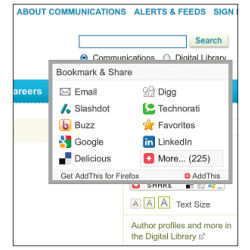
Almost 90% of what we learn comes from reading, estimates say, and the path that online information takes to your brain is less direct than most. Search engines send 61% of traffic to the average Web site, and referring sites send 17%. Communications‘ site reverses these numbers but still gets most of its readers from someplace else: 56.6% from referring sites, like Slashdot or Reddit, and 14.3% from search engines. Google alone sends 13.6%.
Referring sites are Communications‘ hitmakers. They sent most readers to the site’s most popular stories in the past year. Over 75% of the online readers of “You Don’t Know Jack About Software Maintenance” (http://cacm.acm.org/magazines/2009/11/48444) and over 78% of those who read “The Status of the P Versus NP Problem” (http://cacm.acm.org/magazines/2009/9/38904) were referred. These stories became hits days after they were posted. “What Should We Teach New Software Developers? Why?” (http://cacm.acm.org/magazines/2010/1/55760) spiked three days after it was posted. Referring sites can give stories a second life as well. “Logic of Lemmings in Compiler Innovation” (http://cacm.acm.org/magazines/2009/5/24633) took off more than two months after it was posted.
Referring sites are a Web version of word of mouth. The force behind them is readers like you. Motive doesn’t matter. Magnanimity, didacticism, and egoism all produce the same results. They put Communications‘ articles in front of a larger, mostly different audience. If you think something you’ve read on http://cacm.acm.org deserves extra attention, the simplest way to share it is with the SHARE button located on the right column of every article page. The 224 sites accessible from the button at last count testify to its ease of use. Raising a story’s profile not only brings more traffic to the site, but shares and extends ACM’s profile and membership value to an even greater, global audience.




Join the Discussion (0)
Become a Member or Sign In to Post a Comment